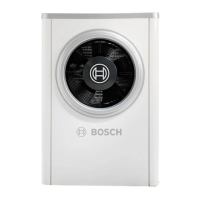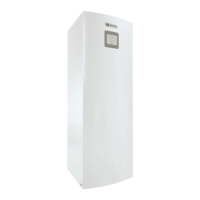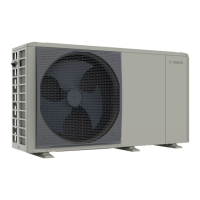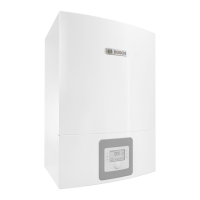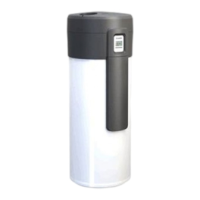Installation
Compress 7400i AW – 6721840487 (2021/10)
10
Fig. 12 Condensate tube connections, valid for all sizes
[1] Condensate line in rainwater gully
[2] Condensate line in gravel bed/stone box
[3] Connection for condensate tube
5.5.2 Connection of heat pump to the indoor unit
NOTICE
Material damage due to excessively high starting torque!
If connections are tightened too tightly, the heat exchanger may be
damaged.
▶ When installing the connection, the tightening torque should be no
more than 150 Nm.
Short pipe runs outdoors reduce heat losses. Use of pre-insulated pipes
is recommended.
▶ Use pipes in accordance with Chapter 7.1.
▶ Connect flow to the indoor unit at the heat transfer medium outlet of
the heat pump ( [1], Fig. 13).
▶ Connect return from the indoor unit at the heat transfer medium inlet
of the heat pump ( [2], Fig. 13).
▶ Tighten connections of the heat transfer medium pipes with a
starting torque of 120 Nm. Direct the force downwards ( Fig. 13)
to avoid lateral loading of the condenser.
If the connection does not seal properly, the joint can be tightened
with a starting torque of up to 150 Nm. If the connection is still not
tight, this indicates that the gasket or connected pipe is damaged.
Fig. 13 Connections of heat carrying medium pipes, valid for all sizes
[1] Heat transfer medium outlet (to the indoor unit) DN25
[2] Heat transfer medium inlet (from the indoor unit) DN25
5.5.3 Electrical connection
NOTICE
Malfunction due to faults!
High-voltage lines (230/400 V) in the vicinity of communication lines
can cause the heat pump to malfunction.
▶ Route sensor cable, EMS-BUS cable and shielded CAN-BUS cable
separately to power cables. Maintain a minimum distance of
100 mm. The BUS cable can be routed together with sensor cables.
It must be possible to safely interrupt the power supply to the device.
▶ If power is not supplied to the heat pump via the indoor unit, install a
separate safety switch that completely de-energizes it. When the
power supply is separate, a separate safety switch is needed for each
supply line.
▶ Select the appropriate conductor cross-sections and cable types for
the respective fuse protection and routing method.
▶ Connect the heat pump according to the wiring diagram. No
additional consumers may be connected.
▶ Ensure to install residual current device based on normative
requirements in each country. We recommend to use residual current
device type B.
▶ When changing the PCB, note the colour coding.
CAN-BUS
NOTICE
The system will be damaged if the 12 V- and the CAN-BUS
connections are confused!
The communication circuits are not designed for 12 V constant voltage.
▶ Check to ensure that the cables are connected to the contacts with
the corresponding markings on the circuit board.
The heat pump and indoor unit are connected to each other by a
communication line, the CAN-BUS.

